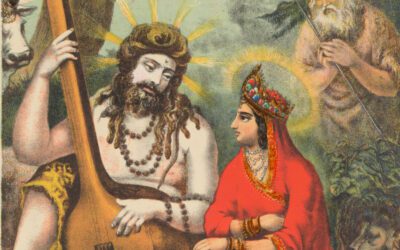Yoga is About the Mind
Beyond its poses, yoga is a path of mind control. The eightfold path of yoga as expounded by Patañjali relies on a regulated practice of self-control and self-awareness. The first two limbs of yoga, namely yama dan niyama, creates the ethical boundaries of the practice. The next stages of asana and prāṇāyāma are focused on one’s posture and breath. The body is seen as the vessel for the soul, the field of action which one utilizes. The remaining four limbs of yoga concern the mind; pratyāhāra is going within the body into the realm of one’s inner world. Dhāraṇā is the focus, dhyāna is the meditation and samādhi is the absorption into the object of one’s focus. The last three limbs are together known as saṃyama. Patañjali (c. 2nd century BCE up to 4th century CE) is said to be the author of the Yoga Sūtra, a text that expounds on this eightfold path. Although many other texts on yoga do persist, the Yoga Sūtra is considered to be the most authoritative due to its brevity and exclusive focus on the yoga school, whilst being inclusive enough to accommodate various sects of the tradition. The Yoga Sūtra (1.2) defines yoga as yogaś-citta-vṛtti-nirodhaḥ or “yoga is the restriction of the movements of the mind”.
Samādhi and Nirvāṇa
The school of yoga is focused on developing the ability to control the mind with the hopes of finally achieving liberation through this samādhi, or absorption. Although many interpretations and elucidations are available on samādhi, especially based on the Yoga Sūtra, in simple words, samādhi is the cessation of the self. Patañjali compares this to a crystal, so pure and transparent, that it takes up the color and appearance of whatever surface it is on. The end goal of samādhi is kaivalya, or the isolation of the self, the purity of the self. In many ways, this parallels with the Buddhist nirvāṇa, also a cessation of the self. Samādhi, however is translated as “absorption” wherein the self enters into something else, or into its Higher Self (i.e. Īśvara or God or the Universe). It then becomes something—the self on itself or kaivalya, absolute purity. Buddhism, on the other hand, does not see the self as something that truly exists. We perceive of a self due to its interdependence with the world (pratītyasamutpāda). In other words, I exist as my parents exist, my parents exist as their parents exist, and so forth. Eventually, the self ceases to exist for one realizes that the self was non-existent to begin with. This is the doctrine of āṇatta, or the non-self. And this differs greatly from the foundational core of yoga and Hinduism, the self or atma. In nirvāṇa, one realizes one is nothing, one is emptiness (śūnyata). Meanwhile, in yoga, one realizes the purity of oneself.
World is Suffering
The impetus for this self-purity and this self-negation is saṃsāra, the repeated birth and death that one experiences in this world. This is a cause of suffering (dukkha) for one is cyclically met with the loss of loved ones, situations, and one’s own life. This suffering is paired with karma or activity, activity that is not freed of its reaction. We therefore must burn them off, experiencing temporary happiness and distress due to these karmic reactions. Both yoga/Hinduism and Buddhism view this world as a source of suffering, conditioning and illusion. What is this illusion? The temporary feeling of attachment, belonging and enchantment. When the world feels real despite it being an illusion or māyā.
Mind Control Techniques
Buddhism focuses on mindfulness, a mental practice that involves being fully present and aware of one’s thoughts, feelings, bodily sensations, and surroundings without judgment. Buddhism emphasizes the cultivation of mindfulness as a path to enlightenment and liberation from suffering. The practice of mindfulness is often associated with the concept of the Four Foundations of Mindfulness (satipaṭṭhānā), as taught by the Buddha, and can be found in various canonical texts, such as the Satipaṭṭhānā Sutta in the Pali Canon and the Māhāsatipaṭṭhānā Sūtra in the Mahāyāna tradition. The yoga tradition, on the other hand, does not teach mindfulness. Instead, it teaches contemplation and deep focus on a particular object/subject. This is what one does at dhāraṇā, and when this focus is maintained, it becomes meditation or dhyāna. Usually a method of meditation known as Trataka is practiced, wherein one focuses on a single object (like a lit candle). Thus, mindfulness is about being fully aware of one’s experience, whilst dhāraṇā is about blurring out distractions and being focused on a particular point.
Investigating the Self
Both yoga and Buddhism agree that we need to control the mind in order to truly understand the suffering that permeates this phenomenal world. Buddhism sees the self as also a byproduct of illusion, and is thus unreal, with the eventual realization that the self does not exist and is also void. Yoga differs greatly, by using the doctrine of the self as the anchor of one’s practice and one’s goal. Both traditions see this world as a karmic trap which we can disassociate from by mental techniques. The path of mindfulness is practiced in Buddhism as a method to be fully aware of one’s experience without latching on to them. The path of yoga, however, requires an anchor for focus and meditation. Off the mat, both traditions have ethical and moral observances and restraints which form as principles for action. These actions include spiritual practices such as worship, study and above all, the development of compassion for all sentient beings. The yoga tradition recommends svādhyāya or self-study/reflection wherein one studies the scriptures as well as reflect on one’s own practice. Buddhism recommends deep investigation into one’s reality through vipassanā, a method of conscious breathing, self-awareness and body scan with the aim of developing insight into the three characteristics of existence: impermanence (anicca), suffering (dukkha), and non-self (āṇatta).
Reality into Void
The Buddha’s teachings of śūnyata or emptiness parallels the Hindu Vedānta school of Advaita which similarly tells us that the soul is there but eventually ceases to retain its identity. Patañjali also tells us about two different samādhis, savikalpa samādhi and nirvikalpa samādhi. Savikalpa samādhi, also known as “samādhi with seed,” is a state of absorption in which the meditator experiences unity with the object of meditation while still maintaining a sense of individual identity. The mind is completely absorbed in the object of meditation, whether it be a mantra, a deity, or a visual image. However, there is still a subtle sense of duality between the meditator and the object. This type of samādhi is characterized by a profound sense of peace, bliss, and clarity. It provides a taste of the ultimate reality but is not yet complete liberation from the sense of individual selfhood. Nirvikalpa samādhi, also known as “samādhi without seed” or “formless samādhi,” is a state of complete absorption in which the meditator transcends all sense of individual identity and merges with the infinite consciousness, without distinction between subject and object. This type of samādhi is characterized by an overwhelming sense of unity, oneness, and transcendence. It is considered the highest state of consciousness attainable in yoga, representing liberation from the cycle of birth and death. Thus, we do have an eventual unity of Buddhism and yoga in the higher stages of yoga practice. Initially, however, the concept of the self acts as this anchor while in latter stages, once no longer needed, one is able to rid of this distinction altogether. By all means, Buddhism and yoga should be respected as separate traditions. Yes, they do achieve the same thing, and have overlapping techniques, therefore the study of both can be complimentary. However, they have very different perspectives at their initial stages and therefore applies contrasting techniques to achieve the same goal. This very simple yet profound inner discovery as substratum of all life force is the natural state of mind …this constant awarenss of the awarness, the constant flux of renewd attention which comes with the comple and utter emphaty and direct identification with the object of attention. This is commonly known as Samyama.




0 Comments